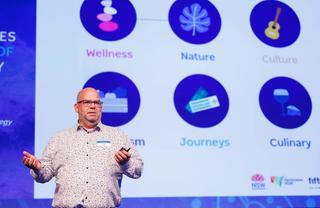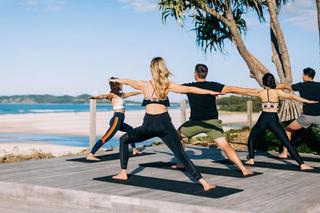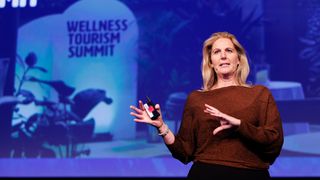Delivering immersive, high-quality and culturally rich visitor experiences was a central theme at the NSW Visitor Economy Forum 2025.
The forum provided an opportunity for the Destination NSW leadership team and industry experts to share insights on the five pillars supporting the NSW Visitor Economy Strategy 2035.
.jpg?rect=0,3,3500,2275&w=320&h=208&auto=format)
Destination NSW Acting Director for Product & Distribution Development Jenny Mitchell (above) outlined pillar four of the Strategy - 'Focus on experiences' - highlighting how today’s travellers increasingly value authenticity, connection and purpose – and are seeking meaningful experiences rather than simply things to do.
“Whether it’s walking on Country with Aboriginal guides, exploring creative precincts, or unwinding in a wellness retreat, these visitors want to engage deeply with people and place. That’s why this pillar is so important,” Ms Mitchell said.
Ms Mitchell said the capability-building NSW First program will remain a cornerstone of Destination NSW’s approach to supporting visitor economy businesses in experience development.
“Our NSW First program will evolve to embrace new ways of working with industry and partners – fostering innovation, collaboration and readiness for emerging trends,” she said.
“This will ensure visitor experiences in NSW are not only authentic and inclusive, but also visible, accessible, sustainable and compelling to the audiences who matter most.”

Attendees also heard from culture research specialist FiftyFive, with Director Peter Firth (above) outlining current trends in domestic tourism – including rising demand for nature-based travel, road trips, and food and wine experiences.
Mr Firth said that despite cost-of-living pressures, Australians were continuing to prioritise travel, often cutting back on other spending to make room for it.
Among major drawcards for NSW were its extensive road tripping network, Aboriginal cultural tourism offering and nature and wellness experiences.
“Road trips, for example, are embedded in Australian travellers’ DNA, with two thirds of domestic travellers interested in taking road trips in NSW,” Mr Firth said.
“NSW leads in this space because of the diversity of visitor experiences offered across the state. It’s also easy reach destinations and find accommodation when you arrive.”
While the breadth of experiences that NSW offers is unparallelled, Mr Firth said the challenge was elevating what is unique. Sydney’s ‘first light’ culture, for example, offered a strong point of difference for visitors.
He shared a quote from an interstate travel survey respondent who said: “It’s about watching the sunrise on Sydney Harbour, enjoying a quiet walk on Bondi Beach or grabbing coffee from local cafes as the city wakes up.
“It also includes the early buzz of markets, joggers at the Royal Botanic Gardens and surfers catching the first waves of the day seeing surfers catching first wave of the day.
“It’s a blend of nature, lifestyle and community that makes Sydney so special in the morning.”
Well Traveller founder Katherine Droga highlighted the rapid growth of wellness tourism and discussed how operators can meaningfully integrate wellness elements into their visitor experiences.
“Wellness is the ultimate sustainable visitor segment,” she said.
“These visitors like to travel out of season, they drive regional dispersal, they tread lightly and they spend more during their trips.
“Adding wellness experiences to existing visitor experiences and conferences is an exciting opportunity to position NSW as a leader in wellness travel in Australia.”

Destination NSW recently partnered with Well Traveller on a new national TV series to showcase NSW’s booming wellness tourism sector to audiences across Australia.
Season two of Well Traveller features destinations including Sydney, the Blue Mountains, Byron Bay, the Coffs Coast and hinterland, the Hunter Valley, Mudgee and the South Coast. More than 70 NSW tourism businesses and eight farmers’ markets were showcased during the Well Traveller partnership via TV segments, editorial content, website listings and social media posts.
Global wellness economy hits a record $6.8 trillion
This week the Global Wellness Institute (GWI) released its Global Wellness Economy Monitor 2025, which provides in-depth data and insights on the global wellness market.
The story emerging from the data: continued, accelerating growth. The wellness market has doubled since 2013, and grew 7.9 per cent from 2023 to 2024, reaching a new peak of $6.8 trillion.
The market was described by GWI as officially beyond “pandemic recovery mode”: all 11 wellness sectors, including wellness tourism, have now exceed their 2019 values, most by significant margins.
GWI said tourism-based wellness sectors were hit hard by the pandemic but roared back between 2023 and 2024: wellness tourism grew 13.8 per cent, spas 14.6 per cent, and thermal/mineral springs 11.1 per cent, making them three of the four largest year-over-year gainers.
Learn more here.
